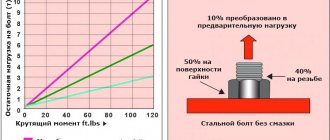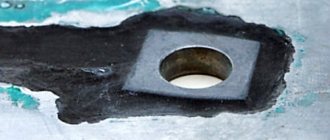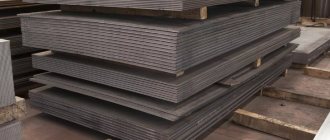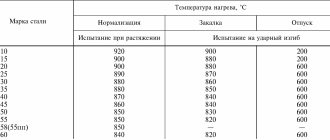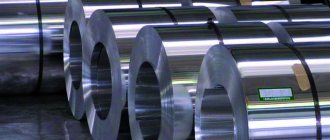Tensile strength
- this is the same as the temporary resistance of the material.
But despite the fact that it is more correct to use the term temporary resistance
, the concept of tensile strength has taken root better in technical colloquial speech.
At the same time, in regulatory documentation and standards the term “temporary resistance” is used. ©ICM(www.modificator.ru)
Strength
- this is the resistance of a material to deformation and destruction, one of the main
mechanical properties
. In other words, strength is the ability of materials to withstand certain influences (loads, temperature, magnetic and other fields) without collapsing.
To the tensile strength characteristics
include normal modulus of elasticity, proportional limit, elastic limit, yield strength and tensile strength (tensile strength).
Tensile strength
— this is the maximum mechanical stress above which destruction of the material subject to deformation occurs; tensile strength is designated σB and is measured in kilograms of force per square centimeter (kgf/cm2), and is also indicated in megapascals (MPa).
There are:
- tensile strength,
- compressive strength,
- bending strength,
- torsional strength.
Short-term strength (MPa)
determined using tensile tests, deformation is carried out until failure. Tensile tests are used to determine tensile strength, elongation, elastic limit, etc. Long-term strength tests are intended primarily to assess the possibility of using materials at high temperatures (long-term strength, creep); as a result, σB/Zeit is determined - the limit of limited long-term strength for a given service life. [1]
©ICM (www.modificator.ru)
Physics of strength
founded by Galileo: summarizing his experiments, he discovered (1638) that in tension or compression, the fracture load
P
for
a given material depends only on the cross-sectional area
F. This is how a new physical quantity appeared - stress σ=P
/
F
- and a physical constant of the material: fracture stress [4].
Physics of fracture as a fundamental science of the strength of metals
arose in the late 40s of the XX century [5]; this was dictated by the urgent need to develop scientifically based measures to prevent the increasingly frequent catastrophic destruction of machines and structures. Previously, in the field of strength and destruction of products, only classical mechanics was taken into account, based on the postulates of a homogeneous elastic-plastic solid body, without taking into account the internal structure of the metal. The physics of destruction also takes into account the atomic-crystalline structure of the metal lattice, the presence of defects in the metal lattice and the laws of interaction of these defects with elements of the internal structure of the metal: grain boundaries, second phase, non-metallic inclusions, etc.
Great influence on the strength of the material
is influenced by the presence of surfactants in the environment that can be strongly adsorbed (moisture, impurities); the tensile strength decreases.
Increasing the strength of a metal is caused by targeted changes in the metal structure, including modification of the alloy.
Educational film about the strength of metals (USSR, year of release: ~1980):
Metal tensile strength
Tensile strength of copper
. At room temperature, the tensile strength of annealed technical copper is σB = 23 kgf/mm2 [8]. As the test temperature increases, the tensile strength of copper decreases. Alloying elements and impurities affect the tensile strength of copper in various ways, both increasing and decreasing it.
Aluminum tensile strength
. Annealed aluminum of technical purity at room temperature has a tensile strength σB = 8 kgf/mm2 [8]. As the purity of aluminum increases, the strength of aluminum decreases and its ductility increases. For example, aluminum cast into the ground with a purity of 99.996% has a tensile strength of 5 kgf/mm2. The tensile strength of aluminum decreases naturally as the test temperature increases. When the temperature drops from +27 to -269°C, the temporary resistance of aluminum increases - 4 times for technical aluminum and 7 times for high-purity aluminum. Alloying increases the strength of aluminum.
©ICM (www.modificator.ru)
Selection of steel based on strength indicators
Based on strength indicators, steel is conventionally divided into three groups:
- with strength of the usual level (σy< 29 kN/cm2);
- with increased strength (29 kN/cm2 ≤ σy< 40 kN/cm2);
- with high level strength (σy ≥ 40 kN/cm2).
Steels that have a normal level of metal strength are represented by low-carbon classes C235 - C285, which have different degrees of deoxidation (boiling, semi-calm and calm).
Steels with increased strength are represented by low-alloy classes C345 - C390. They have high impact strength and a fine-grained structure, which allows them to be used for the production of structures in the “northern version”.
Steels with high-level strength are represented by strength classes C440 – C590.
Due to the high strength of the metal, the use of such steels allows for metal savings, but due to the costs of alloying and heat treatment, they are more expensive in comparison with low-carbon steels of ordinary quality.
Steels C345 and C375 are tested for impact strength at various temperature conditions, which makes it possible to determine the level of danger of brittle fracture taking into account the operating temperature of the structures.
Such steels are supplied in four categories.
For structures erected in climatic regions 1, 2, 2 and 3 when operating in heated rooms, steel grades should be selected as for operating conditions in climatic region 4, except for steels C245 and C275.
Selection of materials for welding
When carrying out construction work in modern conditions, the connection of elements is carried out mainly using electric arc welding.
Taking into account the conditions of production and installation of building structures, the design of the metal elements used, the use of basic materials, it is possible to use electric arc welding, represented by such types as manual, mechanized and automatic.
When welding joints, compliance with their strength characteristics is required, which are determined based on the strength of the metal of the connecting elements, the strength of the deposited weld metal, the shape of the joint and its type, as well as the stresses arising in the joint, the nature of the applied force on the joint, and the welding technology used.
Considering the characteristics of the strength of the deposited weld metal, it should be noted that this indicator is determined by the material of the electrode wire used, the composition of the coating of the electrodes used in manual welding, and the quality of the flux using welding technology in automatic and mechanized mode. With the correct choice of materials, it is possible (subject to compliance with the requirements and technology of the welding process) to ensure the strength of the deposited metal, which in its characteristics is not inferior to the strength of the base metal.
Marking of shaped steel made of steel C235, C245, C255, C275, C285, C345 and C375 is carried out with indelible paint, using the colors shown in the table below:
| Name of steel | Marking colors |
| S235 | Yellow and brown |
| S245 | Yellow and green |
| C 255 | Yellow and blue |
| S275 | Yellow and white |
| S285 | White and brown |
| S345 | Blue and brown |
| S375 | Blue and white |
Ultimate strength of steels
As an example, the tensile strength values of some steels are presented. These values are taken from state standards and are recommended (required). The actual values of the tensile strength of steels, as well as cast irons, as well as other metal alloys, depend on many factors and must be determined, if necessary, in each specific case.
For steel castings made from unalloyed structural steels provided for by the standard (steel casting, GOST 977-88), the tensile strength of steel is approximately 40-60 kg/mm2 or 392-569 MPa (normalization or normalization with tempering), strength category K20-K30. For the same steels after quenching and tempering, the regulated strength categories are KT30-KT40, and the tensile strength values are no less than 491-736 MPa.
For structural high-quality carbon steels (GOST 1050-88, rolled products up to 80 mm in size, after normalization):
- Tensile strength of steel 10
: Steel 10 has a short-term tensile strength of 330 MPa. - Tensile Strength of Steel 20
: Steel 20 has a short-term tensile strength of 410 MPa. - Tensile strength of steel 45
: Steel 45 has a short-term tensile strength of 600 MPa.
Steel strength categories
Strength categories of steels (GOST 977-88) are conventionally designated by the indices “K” and “KT”; the index is followed by a number that represents the value of the required yield strength. The index “K” is assigned to steels in the annealed, normalized or tempered state. The “KT” index is assigned to steels after quenching and tempering.
Correspondence between steel grade and cost
There is an opinion that by using the lowest grade of steel, which is also the cheapest, it is possible to achieve the minimum cost of the structure. In fact, as the strength of steel increases, the total weight of the structure decreases, therefore, in the end, the cost of consumed rolled steel will be lower. In addition, there is a reduction in the load on the foundation and the level of seismic loads.
But it must be taken into account that the use of high-strength steels is not advisable if the selection of the cross-section is carried out taking into account ensuring stability.
When choosing steel grades, it is recommended to obtain information from suppliers about the availability and possibility of supplying the required material. This measure is necessary, since replacing it with a less durable one requires changing profiles and components, which increases construction time, and replacing a profile with a stronger one will lead to excessive consumption of steel. Steels 09G2S and St3sp/ps5 are among the most common and in demand.
Composition of chemical elements of steel according to analysis of a ladle sample:
| Name of steel | Mass fraction of element, % | |||||||||
| carbon, no more | manganese | silicon | sulfur, no more | phosphorus | chromium | nickel | copper | vanadium | other elements | |
| S235 | 0,22 | No more than 0.60 | No more than 0.05 | 0,05 | No more than 0.040 | No more than 0.30 | No more than 0.30 | No more than 0.30 | — | — |
| S245, S275, S345T, S375T | 0,22 | No more than 0.65 | 0,05-0,15 | 0,05 | No more than 0.040 | No more than 0.30 | No more than 0.30 | No more than 0.30 | — | — |
| S255, S285, S345T, S375T | 0,22 | No more than 0.65 | 0,15-0,30 | 0,05 | No more than 0.040 | No more than 0.30 | No more than 0.30 | No more than 0.30 | — | — |
| 0,22 | 0,8-1,10 | 0,05-0,15 | 0,05 | No more than 0.040 | No more than 0.30 | No more than 0.30 | No more than 0.30 | — | — | |
| 0,2 | 0,8-1,10 | 0,15-0,30 | 0,05 | No more than 0.040 | No more than 0.30 | No more than 0.30 | No more than 0.30 | — | — | |
| S345, S375, S390T | 0,15 | 1,30-1,70 | No more than 0.80 | 0,04 | No more than 0.035 | No more than 0.30 | No more than 0.30 | No more than 0.30 | — | — |
| S345K | 0,12 | 0,30-0,60 | 0,17-0,37 | 0,04 | 0,070-0,120 | 0,50-0,80 | 0,30-0,60 | 0,30-0,50 | — | Aluminum 0.08-0.15 |
| S390 | 0,18 | 1,20-1,60 | No more than 0.60 | 0,04 | No more than 0.035 | No more than 0.40 | No more than 0.30 | No more than 0.30 | 0,07-0,12 | Nitrogen 0.015-0.025 |
| S390K | 0,18 | 1,20-1,60 | No more than 0.17 | 0,04 | No more than 0.035 | No more than 0.30 | No more than 0.30 | 0,20-0,40 | 0,08-0,15 | Nitrogen 0.015-0.025 |
| S440 | 0,2 | 1,30-1,70 | No more than 0.60 | 0,04 | No more than 0.035 | No more than 0.40 | No more than 0.30 | No more than 0.30 | 0,08-0,14 | Nitrogen 0.015-0.025 |
| S590 | 0,15 | 1,30-1,70 | 0,40-0,70 | 0,035 | No more than 0.035 | No more than 0.30 | No more than 0.30 | No more than 0.30 | 0,07-0,15 | Molybdenum 0.15-0.25 |
| S590K | 0,14 | 0,90-1,40 | 0,20-0,50 | 0,035 | No more than 0.035 | 0,20-0,50 | 1,40-1,75 | No more than 0.30 | 0,05-0,10 | Molybdenum 0.15-0.25 |
| Nitrogen 0.02-0.03 | ||||||||||
| Aluminum 0.05-0.1 | ||||||||||
Tensile strength of cast iron
The method for determining the tensile strength of cast iron is regulated by GOST 27208-87 (Cast iron castings. Tensile tests, determination of tensile strength).
Tensile strength of gray cast iron
.
Gray cast iron (GOST 1412-85) is marked with the letters SCh, followed by numbers that indicate the minimum value of the cast iron's tensile strength - tensile strength (MPa * 10-1). GOST 1412-85 applies to cast iron with flake graphite for castings of grades SCh10-SCh35; This shows that the minimum tensile strength of gray cast iron
in the cast state or after heat treatment varies from 10 to 35 kgf/mm2 (or from 100 to 350 MPa). Exceeding the minimum tensile strength of gray cast iron is allowed by no more than 100 MPa, unless otherwise specified.
Tensile strength of ductile iron
. The marking of high-strength cast iron also includes numbers indicating the tensile strength of cast iron (tensile strength), GOST 7293-85. The tensile strength of ductile iron is 35-100 kg/mm2 (or 350 to 1000 MPa).
From the above it is clear that nodular cast iron can successfully compete with steel.
Definition of steel according to regulatory documents
It is necessary to establish the climatic region of construction work, know the outside air temperature, guided by SP 131.13330.2012 (as amended by SNiP 23-01-99*).
According to SP 16.13330.2011, the temperature of the coldest day with an index of 0.98 is taken for calculations. According to SNiP II-23-81 - the temperature observed during the coldest five-day period, with an index of 0.92.
The effect of temperature on steel grade is explained by the property of increasing brittleness of steel with decreasing temperature.
The use of SP 16.13330.2011 from July 1, 2015 is mandatory, therefore data from this source should be used in calculations. For comparison, you can analyze the requirements of SP 16.133302011 and the no longer valid SNiP II-23-81.
Let's consider table B.1 SP 16.13330.2011, where the following types of materials are assigned for the designed structures:
| Steel grade according to | Conditions for using steel at design temperature, °C | |||||||||||||
| t ≥ -45 | -45 > t ≥ -55 | t < -55 | ||||||||||||
| GOST 27772 | GOST 535, GOST 14637 | GOST 19281 | for groups of structures | |||||||||||
| 1 | 2 | 3 | 4 | 1 | 2 | 3 | 4 | 1 | 2 | 3 | 4 | |||
| S235 | St3kp2, St3ps2 | — | — | + | + | — | — | — | — | — | — | — | — | |
| S245 | St3ps5 | — | + | x | — | — | — | — | + | — | — | — | + | |
| S255, S285 | St3sp5 | + | x | x | — | — | — | — | + | — | — | — | + | |
| S345, S375 | 09G2S | 3 | 1 | 1 | — | 3 | 3 | 1 | — | 4 | 4 | 2 or 3 | ||
| 12 | 4 | 4 | 12 | 12 | 4 | 15 | 15 | 7 or 12 | ||||||
The table has 3 columns indicating the standards for choosing a steel grade. The steel grade GOST 27772 indicates the yield strength of the metal, for example, C235 - the yield strength of steel is 235 N/mm2, the chemical composition of the steel is indicated by the markings GOST 353, GOST 14637 and GOST 19281, strength characteristics are indicated in GOSTs.
Steel produced according to the requirements of one GOST may correspond in its characteristics to material made according to another GOST; they will differ only in the methods of steel quality control. There is no single standard in the world that regulates the designation of steel grades; the standards used in Russia, the USA, and European countries are different, but this does not mean that the steel has different composition and quality.
According to Table 50 of SNiP II-23-81, the following steel grades are assigned:
| Steel | GOST or TU | Steel category for the climatic region of construction (design temperature, °C) | ||
| II4 (-30 > t ≥ — 40); II5 and others (t ≥ -30) | I2, II2 and II3 (-40 > t ≥ -50) | I1 (-50 > t ≥ -65) | ||
| Group 1. Welded structures or their elements operating in particularly difficult conditions or directly exposed to dynamic, vibration or moving loads [crane beams; work platform beams; structural elements of bunker and unloading platforms that directly bear the load from rolling stock; truss gussets; span structures of conveyor galleries; welded special supports for large crossings of power lines (VL) with a height of more than 60 m; elements of guy lines for masts and guy lines; beams for cranes of hydraulic structures, etc.]. | ||||
| S255 | GOST 27772-88 | + | — | — |
| S285 | + | — | — | |
| S345 | 3 | 3 | 4a) | |
| S375 | 3 | 3 | 4a) | |
| S390 | + | + | +b) | |
| S390K | + | + | +b) | |
| S440 | + | +b) | +c) | |
| Group 2. Welded structures or their elements operating under static load [trusses; frame crossbars; floor and roof beams; stringers of stairs; overhead line supports, with the exception of welded supports of large transitions; busbar supports for open switchgear substations (OSU); supports for outdoor switchgear switches; supports for conveyor galleries; elements of the transport contact network (rods, anchor guys, clamps); floodlight masts; elements of combined supports of antenna structures; pipelines of hydroelectric power stations and pumping stations; lining of water pipelines; embedded parts of gates and other stretched, stretched-flexible and bendable elements], as well as structures and their elements of group 1 in the absence of welded joints and suspended track beams made of I-beams in accordance with GOST 19425-74* and TU 14-2-427-80, if available welded installation connections. | ||||
| S245 | GOST 27772-88 | +d) | — | — |
| S255 | + | — | — | |
| S275 | +d) | — | — | |
| S285 | + | — | — | |
| S345 | 1 | 3 | 4a,d) | |
| S345K | + | — | — | |
| S375 | 1 | 3 | 4a,d) | |
| S390 | + | + | +b) | |
| S390K | + | + | +b) | |
| S440 | + | + | +c) | |
| S590 | + | — | — | |
| S590K | — | + | + | |
| VSt3kp up to 4 mm thick | GOST 10705-80*, group B, table. 1 | 2e) | 2e) | — |
| VSt3ps up to 5.5 mm thick | Same | 2e) | — | — |
| VSt3ps thickness 6-10 mm | « | 6 | — | — |
| 16G2AF thickness 6-9 mm | TU 14-3-567-76 | + | + | + |
| Group 3. Welded structures or their elements operating under static load [columns; racks; base plates; flooring elements; structures supporting process equipment; vertical connections along columns with stress, in connections exceeding 0.4 Ry; anchor, load-bearing and fixing structures (supports, crossbars, clamps) of the transport contact network; supports for outdoor switchgear equipment, except for supports for switches; elements of trunks and towers of antenna structures; columns of concrete trestles, covering purlins and other compressed and compressed-bending elements], as well as structures and their elements of group 2 in the absence of welded joints. | ||||
| S235 | GOST 27772-88 | +e,i) | — | — |
| S245 | + | — | — | |
| S255 | + | +g) | — | |
| S275 | + | — | — | |
| S285 | + | +g) | — | |
| S345 | 1 | 1 | 2 or 3 | |
| S345K | + | + | — | |
| S375 | 1 | 1 | 2 or 3 | |
| S390 | + | + | + | |
| S390K | + | + | + | |
| S440 | + | + | + | |
| S590 | + | — | — | |
| S590K | — | + | + | |
| VSt3kp up to 4 mm thick | GOST 10705-80*, group B | 2e) | 2e) | — |
| VSt3kp thickness 4.5-10 mm | Same | 2e) | — | — |
| VSt3ps thickness 5-15 mm | GOST 10706-76*, group B, with additional requirement | 4 | — | — |
| VSt3ps up to 5.5 mm thick | GOST 10705-80*, group B | 2e) | 2e) | — |
| VSt3ps thickness 6-10 mm | GOST 10705-80*, group B | 6 | — | — |
| VSt3sp thickness 5-15 mm | GOST 10706-76*, group B, with additional requirement | — | 4 | — |
| VSt3sp 6-10 mm thick | GOST 10705-80*, group B | — | 5 | — |
| 16G2AF thickness 6-9 mm | TU 14-3-567-76 | + | + | + |
| Group 4. Auxiliary structures of buildings and structures (connections, except those specified in group 3; timber frame elements; stairs; ladders; platforms; fences; metal structures of cable channels; secondary elements of structures, etc.), as well as structures and their elements of group 3 in the absence of welded joints. | ||||
| S235 | GOST 27772-88 | + | — | — |
| S245 | — | + | + | |
| S255 | — | + | + | |
| S275 | — | + | + | |
| S285 | — | + | + | |
| VSt3kp up to 4 mm thick | GOST 10705-80*, group B | 2e) | 2e) | 2e) |
| VSt3kp thickness 4.5-10 mm | Same | 2e) | — | — |
| VSt3ps thickness 5-15 mm | GOST 10706-76*, group B, with additional requirement | 4 | 4 | — |
| VSt3ps up to 5.5 mm thick | GOST 10705-80*, group B | 2e) | 2e) | 2e) |
| VSt3ps thickness 6-10 mm | Same | 6 | 6 | — |
The temperature gradation given in SNiP II-23-81 is 5 degrees lower than in SP 16.13330.2011, but the temperature adopted does not correspond to the coldest day, but characterizes the temperature of the coldest five-day period.
When studying the joint venture “Construction Climatology”, one can see that in the vast majority of accepted conditions will be equivalent, but there are cases when SNiP stipulates more stringent requirements, and in some cases the requirements in the joint venture will be higher. Therefore, the examination requires compliance of the steel grade with the regulatory values of SP 16.13330.2011, however, if SNiP II-23-81 imposes more stringent requirements, it is recommended to use this document.
If it is necessary to select a material for connections of steel structures, it is necessary to use Appendix G SP 16.13330.2011.
By considering the SP tables, you can determine the recommended options for steel grades and perform calculations. If there is a choice, several options should be studied in order to, using the data from the feasibility study, select the best option.
In each of the given groups of structures, data on impact strength at different temperature conditions of steel operation are provided.
To select steel and make a decision within each group, a comparison of TECs must be made that determine the dependence of the cost of the structure on steel consumption.
